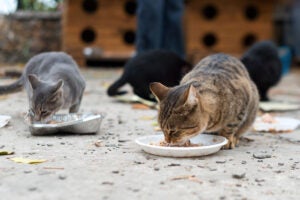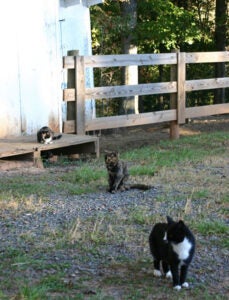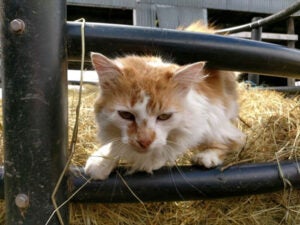The New York Times has published an article highlighting the struggles with homeless and feral cats living in the streets of New York City. The author notes that it’s the poorer places in the city that have more cats — the places with more abandoned cars, homes, and more alleyway crevices to hide in.
Although impossible to count all the cats, it’s estimated that there are over a half million cats roaming the streets of the city! The author interviewed a few residents who care for their feline neighbors and asked them why they care so much about these feral cats. The NYC cat lovers feel bad for the hungry or sick cats and leave what they can for them. But the bird watchers in the city want the cats gone. They estimate that these cats are killing 2.4 billion birds a year.
Does this storyline sound familiar to you? Because it sure does to me! Surely everyone has been on a farm that feels overrun by barn cats — the ones that live in any cozy crevice they can find. Just like NYC, on the farm there’s always one person who loves them while so many others hate them!

The New York Times article reminds me of a dairy farm that I grew up working on, and one moment in particular summarizes the feelings the different managers had for the barn cats.
It was January, and the farm owners were getting their financial summaries done for the previous year. It was a tall task, but they worked out exactly how much was spent on each area of the farm. One morning while I was milking cows, the anti-cat farm owner said, “Can you believe what I found in my business summary? I am spending $100 a month on cat food. I pay so much I had to create an ‘other livestock’ expense category!”
Shortly after our conversation, the cat-loving manager walked in, and said this “other livestock” had an important rodent control job, so he thought we should take care of them!
Much like in NYC, there is such a thing as too many cats, but they can have their upsides too!
Although a big city rat would give a cat a run for its money, rats are not likely to cohabitate with cats, so just having cats around could cause rats to keep their distance. Because cats do eat mice, they reduce the damage that rodents can do to structures and grain bins, as well as preventing the mice from spreading diseases.
If you’re a cat lover, then having barn cats is crucial to the farming experience! But having too many cats can be a problem, they get into places you don’t want them, drink out of milk pails, and not to mention all the cat poop!

Many farmers with a veterinarian are able to afford to fix cats for very cheap, which is an effective way to keep the population down over time, but the people in NYC don’t have access to our vets.
Many groups such as the Alley Cat Allies, the Mayor’s Alliance for NYC’s Animals, and Flatbush Cats advocate for trap, neuter and release (TNR). These groups are helping to TNR the cats of the city to slow down the rate the population increases. The New York Times article mentions that the average life of a NYC street cat is likely only around four years, so TNR should be an effective measure as long as they trap cats young.
A lesson we have all learned, and now residents of NYC are too, is that once you start feeding them there’s no turning back! One woman interviewed by The New York Times said she feeds the cats before 5 a.m. to avoid arguments with her cat-loathing neighbors!
Being overrun with cats is hardly headline news for us farmers, but it’s nice to know that our barn cat struggle is a shared one!

Elizabeth Maslyn is a born-and-raised dairy farmer from Upstate New York. Her passion for agriculture has driven her to share the stories of farmers with all consumers, and promote agriculture in everything she does. She works hard to increase food literacy in her community, and wants to share the stories of her local farmers.



